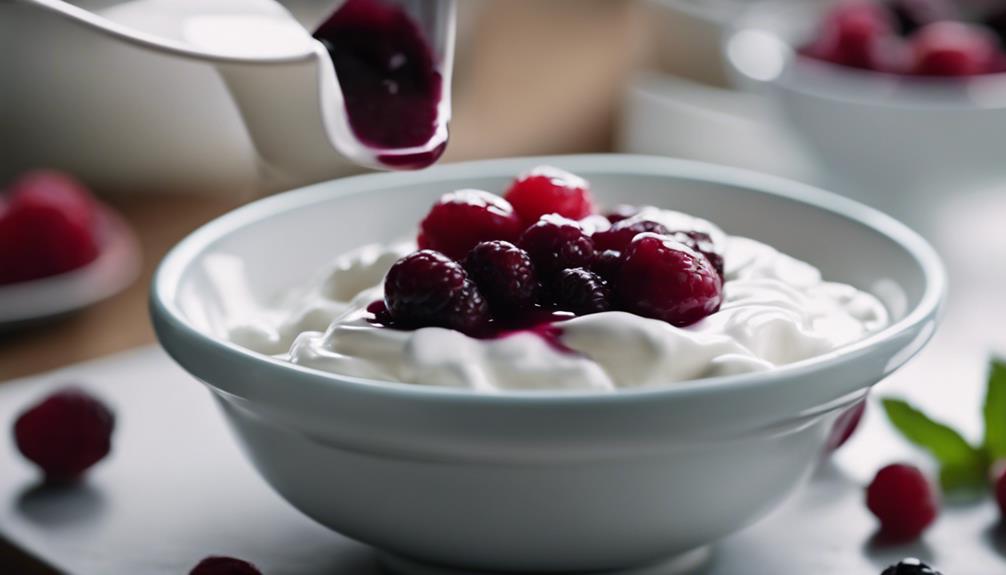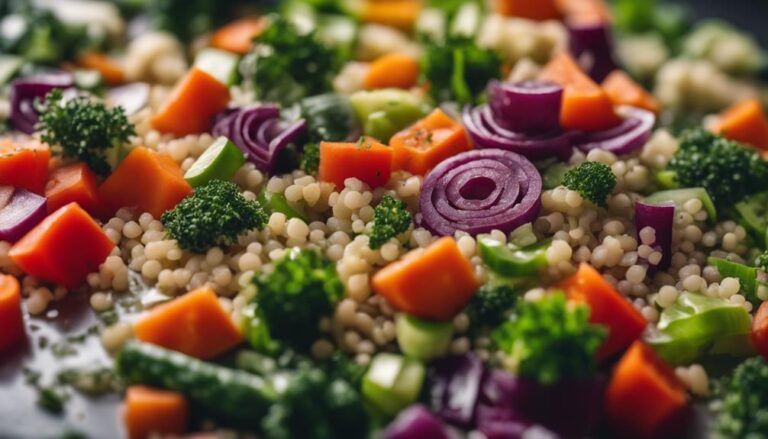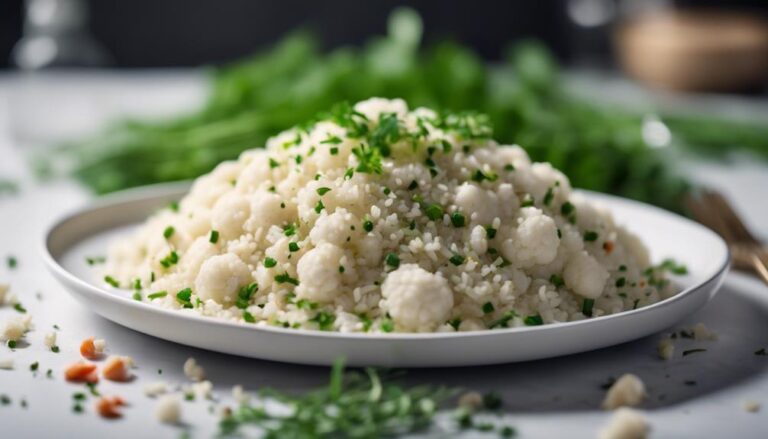Sous Vide Berry Compote Over Low-Fat Greek Yogurt
Enhance your low-fat Greek yogurt with a rich berry compote prepared using the sous vide method. Experience the precise flavors and textures created by sealing and slow-cooking your ingredients in a water bath. The gentle process guarantees maximum flavor infusion and consistent results. Achieve a perfect balance between tangy fruitiness and creamy yogurt goodness. Elevate your breakfast or dessert with this indulgent yet nutritious treat. Uncover the secrets to making your berry compote shine over yogurt. More tips await to help you master this sous vide culinary adventure.
What You Will Learn Here
- Sous vide berry compote offers balanced flavors.
- Convenience makes it suitable for any time of day.
- Versatile option for dessert or breakfast.
- Long refrigerator storage adds convenience.
- Culinary experience is both wholesome and decadent.
Origin of the Technique
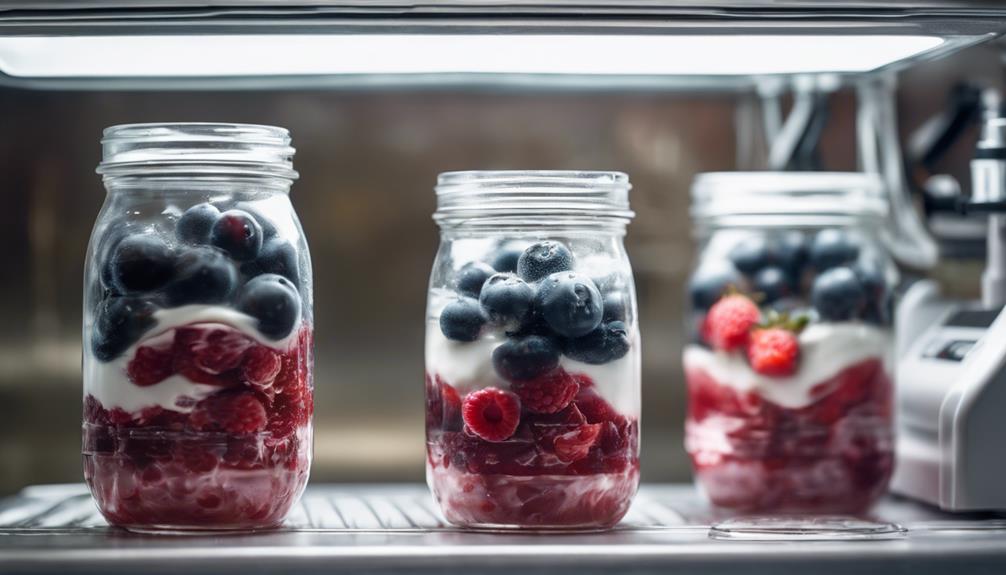
The sous vide technique, originating in 1970s France, revolutionized cooking with its precise temperature control. Initially embraced by professional kitchens, it eventually found its way into home cooking, transforming the culinary landscape.
This method involves vacuum-sealing food and cooking it in a water bath. It has since evolved to encompass a wide array of recipes, ensuring superior flavor, texture, and nutrient retention in dishes.
Technique Origins
Originating in the innovative culinary landscape of the 1970s, the sous vide technique revolutionized cooking with its precise temperature control method. Initially designed for cooking vacuum-sealed food in a water bath at consistent temperatures, sous vide has evolved to encompass a wide array of dishes, including the delicate process of making sous vide yogurt.
This method involves carefully controlling the temperature of the milk mixture to achieve the desired texture and flavor in the yogurt. The origins of sous vide can be traced back to French chefs who sought a way to achieve unparalleled precision in their culinary creations. Today, sous vide has found its way into home kitchens, allowing amateur chefs to effortlessly produce restaurant-quality dishes with minimal hassle.
Historical Background
Pioneered by French chef Georges Pralus in the 1970s, the sous vide cooking technique revolutionized culinary precision with its innovative approach to temperature control. The term 'sous vide,' meaning 'under vacuum' in French, highlights the method's use of vacuum-sealed bags for cooking.
Initially created to perfect foie gras, this technique's precise temperature regulation guarantees consistent results and ideal food texture. Sous vide has become popular in both professional and home kitchens because it preserves flavors and nutrients exceptionally well.
In relation to milk-based products like Greek yogurt, sous vide can be utilized to pasteurize milk gently before turning it into yogurt, ensuring a safe and controlled process that maintains the milk's quality and taste.
Method Evolution
Revolutionizing culinary precision through innovative temperature control techniques, the evolution of sous vide cooking method traces back to its industrial food production roots in France during the 1960s.
Originally designed to maintain consistency in large-scale food manufacturing, sous vide has since shifted into a beloved culinary practice celebrated for its ability to guarantee perfect results every time.
By sealing ingredients in airtight bags and immersing them in a precisely heated water bath, sous vide promises even cooking and flavor retention.
This technique's journey from industrial kitchens to home settings has been marked by the development of affordable immersion circulators, making it accessible to food enthusiasts everywhere.
Whether you're cooking yogurt, berries, or any other ingredient, sous vide promises a delightful culinary experience with minimal effort.
Yogurt Cultures and Milk
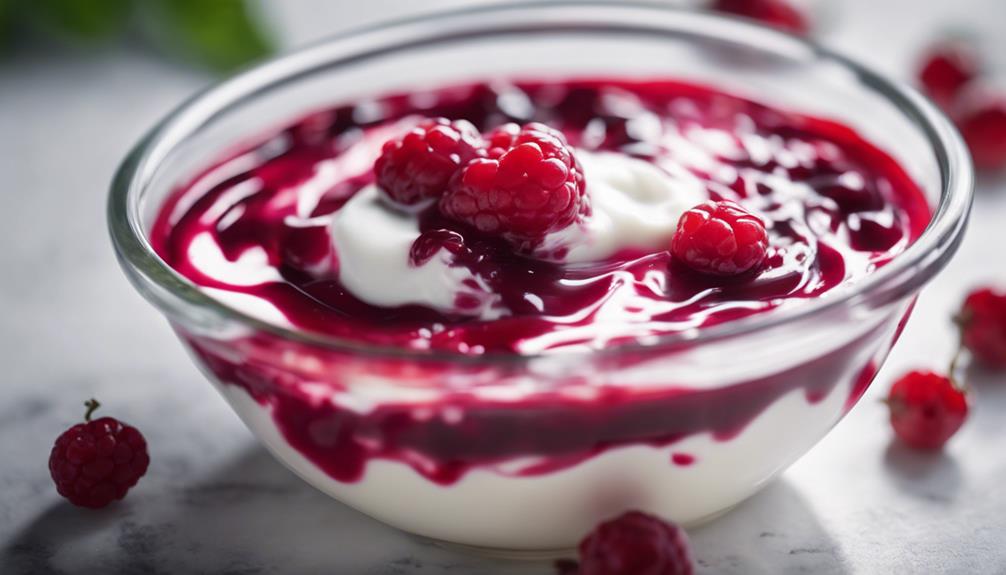
In the world of yogurt making, the selection of the right milk and the presence of essential yogurt cultures are pivotal for achieving the desired creamy consistency and tangy flavor. When making Greek yogurt using the sous vide method, paying attention to these elements is critical.
- Yogurt Cultures: Lactobacillus bulgaricus and Streptococcus thermophilus are essential for fermentation, converting lactose in the milk to lactic acid, which thickens the yogurt.
- Milk Proteins: High temperatures can denature milk proteins, affecting the final texture of the yogurt. Maintaining the right temperature range of 95°F to 115°F is crucial for successful fermentation.
- Milk Selection: Choosing between whole milk and low-fat options impacts the richness and texture of the yogurt. Whole milk yields a creamier result, while low-fat options offer a lighter alternative.
- Consistency Control: Achieving the desired yogurt consistency involves a delicate balance of milk choice, temperature regulation, and the presence of active cultures.
Yogurt-Filled Sous Vide Baguettes
When you delve into the world of yogurt-filled sous vide baguettes, you're in for a treat.
These baguettes aren't your average sandwiches; they're a symphony of flavors and textures.
Get ready to experience the perfect blend of crunchy baguette, creamy yogurt, and a burst of complementary ingredients.
Jar-Sealing Sous Vide Technique
Using mason jars for the jar-sealing sous vide technique provides a dependable method for cooking and storing delicate foods like yogurt-filled sous vide baguettes with precision and convenience. The airtight seals on the jars guarantee that water doesn't seep in during the sous vide process, maintaining the flavors and textures of your homemade yogurt.
Here are some benefits of using the jar-sealing sous vide technique:
- Allows for precise temperature control, ideal for delicate foods.
- Convenient individual portion sizes can be cooked and stored.
- Helps preserve the freshness and flavors of the food.
- Ensures safe cooking practices with sealed jars.
This method is perfect for creating delicious and perfectly cooked yogurt-filled sous vide baguettes.
Yogurt-Filled Baguette Sandwiches
For a delicious twist on traditional baguette sandwiches, consider filling them with creamy yogurt using the sous vide method for a perfectly textured and flavorful experience.
When you make yogurt-filled baguette sandwiches, you're in for a treat that combines the crispiness of the bread with the smoothness of the yogurt.
Here are some reasons why you should try this unique culinary delight:
- Delicious and Convenient: Yogurt-filled baguette sandwiches are a delicious and convenient meal option.
- Even Heating: Sous vide baguettes guarantee consistent heating and perfect texture for the sandwiches.
- Creamy and Tangy: Filling the baguettes with yogurt adds a creamy and tangy element to the dish.
- Customizable: This recipe can be personalized with various fillings like veggies, meats, or spreads.
Enjoy the portable and satisfying lunch or snack choice that yogurt-filled baguette sandwiches offer!
Sous Vide Fruit Cups
To craft flavorful and perfectly textured Sous Vide Fruit Cups, start by combining whole milk, yogurt with live cultures, and your choice of fruits in sealed containers for precise cooking.
The immersion circulator guarantees a constant temperature, facilitating proper fermentation and consistency in the yogurt-filled cups.
These fruit-filled yogurt cups can be customized with different fruits, jams, or preserves to enhance flavor and variety.
Sous Vide Fruit Cups provide a convenient and hands-off method for creating individual servings of delicious yogurt desserts or snacks.
- Customizable with different fruits, jams, or preserves
- Immersion circulator maintains steady temperature for proper fermentation
- Hands-off technique for making individual servings
- Guarantees a creamy and delicious treat
Preventing Jar Cracks
Prevent jar cracks by choosing high-quality, tempered glass jars designed for temperature changes. Confirm jars are tightly sealed to avoid water infiltration that can result in sudden temperature shifts causing cracks.
Position jars on a rack above the bottom of the sous vide container to prevent direct heat contact and reduce the risk of cracking.
Jar Material Selection
When selecting jars for your sous vide berry compote, prioritize high-quality, heat-resistant options like tempered glass or silicone to safeguard against potential cracking. These materials are sturdy and can withstand the heat and pressure of the sous vide cooking method. To help you make an informed decision, here's a comparison table:
| Jar Material | Durability | Heat Resistance |
|---|---|---|
| Tempered Glass | High | Excellent |
| Silicone | Moderate | Good |
| Plastic | Low | Poor |
Opting for tempered glass jars offers the best durability and heat resistance, ensuring your jars remain intact throughout the cooking process. Remember, the right jar material is key to a successful sous vide cooking experience, so choose wisely to avoid any mishaps.
Proper Water Level
Maintain the water level in your sous vide bath to safeguard against thermal shock and potential jar cracking during the cooking process. Guarantee the water adequately covers the jars for even heat distribution, preventing any hot spots that could cause the jars to crack.
Inadequate water levels may lead to uneven cooking temperatures, increasing the risk of jar breakage due to sudden changes in heat. Proper water level guarantees a stable and consistent temperature environment essential for successful yogurt making.
Remember to monitor the water level continuously while using the sous vide method to avoid any fluctuations that could compromise the integrity of the jars. By paying attention to this detail, you can enjoy a seamless cooking experience without any unexpected jar mishaps.
Slow Temperature Changes
To safeguard your jars from potential cracks, guarantee a gradual shift in temperature during sous vide cooking to maintain the integrity of the glass containers. Slow temperature changes play an important role in preventing thermal shock that can lead to cracking.
When moving from sous vide to an ice bath, make sure a gradual cooling process to protect the jars. Rapid temperature shifts can stress the glass, increasing the risk of breakage.
By allowing for gradual heating or cooling of the jars, you promote even heat distribution, safeguarding your containers from damage. Sudden changes in temperature pose a threat to jar integrity and could potentially ruin your yogurt or recipe.
Final Thoughts
In reflecting on the indulgent yet nutritious experience of enjoying Sous Vide Berry Compote over creamy Greek yogurt, it becomes evident that this simple recipe offers a delightful balance of flavors and convenience for any time of day. The marriage of the vibrant mixed berries, slowly cooked sous vide to preserve their essence, with the creamy low-fat Greek yogurt creates a harmonious blend that tantalizes the taste buds. The sweetness of the berries complements the tanginess of the yogurt, resulting in a satisfying treat that isn't only delicious but also packed with nutrients.
The versatility of this compote is another aspect worth noting. Whether you choose to savor it as a dessert after dinner or indulge in it as a luxurious breakfast, the sous vide berry compote over low-fat Greek yogurt is a versatile option that can elevate any meal. Additionally, the ability to store the compote in the refrigerator for weeks adds a layer of convenience, making it an ideal topping to have readily available whenever cravings strike. Embrace the simplicity and richness of this delightful combination for a culinary experience that's both wholesome and decadent.
Frequently Asked Questions
Can You Sous Vide Greek Yogurt?
Yes, you can sous vide Greek yogurt. It involves heating milk to precise temperatures with live cultures. Sous vide desserts, Greek yogurt hacks, and healthy cooking techniques benefit from this method. Customize thickness and tanginess to your liking.
Can You Cook With Fat-Free Greek Yogurt?
Yes, you can cook with fat-free Greek yogurt. It offers yogurt alternatives with health benefits like protein and probiotics. Pair it with fruits, herbs, or spices to enhance flavor. Experiment with it in sauces, dressings, and more for a lighter twist.
Can I Use 0 Fat Greek Yogurt in Baking?
Yes, you can use 0 fat Greek yogurt in baking. It's a great dairy alternative, providing moisture and richness while reducing fat content. Adjust for changes in moisture to maintain the desired consistency. It's a versatile baking substitution.
How Do You Thicken Low Fat Greek Yogurt?
To thicken low-fat Greek yogurt, you can strain it, refrigerate for a thicker consistency, or add gelatin, cornstarch, or powdered milk. Avoid high-fat ingredients like heavy cream. Experiment with sweetening options and pair with fruits for varied textures and flavors.
Conclusion
Indulge in the luxurious combination of sous vide berry compote and low-fat Greek yogurt. The delicate balance of sweet and tangy flavors will tantalize your taste buds with each spoonful.
Whether enjoyed as a breakfast treat or a satisfying dessert, this dish offers a delightful experience that's both simple to prepare and incredibly satisfying.
Elevate your yogurt game with this delectable sous vide creation that's sure to impress.
